#Warehouse Management System Software Development
Explore tagged Tumblr posts
Text
Custom Warehouse Management System
Drive efficiency in warehouse operations with Adverb's cutting-edge automation technologies. Our solutions cover material movement, sortation, picking, storage, and reverse logistics, featuring mobile robots, ASRS, and warehouse management software designed for pharma, e-commerce, grocery, cold storage, solar, and battery industries.
#How to build Warehouse Management Software#Warehouse Management System Software Development#Warehouse Management System Development
0 notes
Text
Track, manage, and scale your business operations with our Distribution Management System Software. Optimize your supply chain with smart solutions and improve operational efficiency today.
#Document Management System#Document Management System Dubai#Document Management Software#supply chain management software Dubai#ERP Development Company Dubai#odoo ERP software Dubai#odoo erp solution in dubai#odoo ERP in dubai#warehouse management software Dubai#Best Warehouse Management Software Dubai#Best warehouse management software UAE#odoo partner dubai#odoo software development
0 notes
Text
How order management system software Can Transform Your Business
Imagine a customer reaching out to inquire about their order, or facing delays in getting products to your customers. These situations can be stressful for both you and your customers.
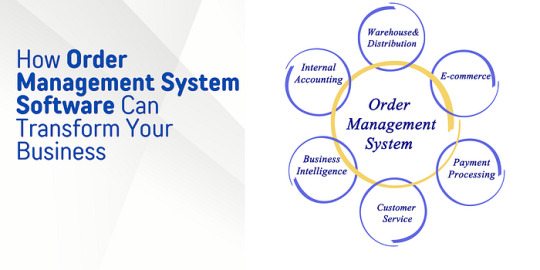
The Order Management System (OMS) to the Rescue
Struggling with lost orders and frustrated customers? Inefficient order processing can be a pain for any business. Enter the Order Management Systems (OMS), a software solution designed to streamline your entire order journey.
From the moment a customer clicks “buy” to the moment their package arrives, an OMS keeps everything organized and on track. Say goodbye to chaos and hello to a smoother, more efficient business.
Ever feel overwhelmed keeping track of orders, making sure you have enough stock, and getting things delivered on time? That’s where an Order Management System (OMS) comes in. Think of it as a digital command center for your entire order fulfillment process.
What is an Order Management System (OMS)?
An OMS is basically a software solution order management system software that automates the whole order lifecycle, from the moment a customer clicks “buy” to when they receive their goodies. It handles three key tasks:
Processing Orders: No more scrambling to manage orders from different channels (website, phone, etc.). An OMS puts them all in one place, streamlining the process and reducing errors.
Managing Inventory: No more stock outs or overselling! An OMS keeps a close eye on your inventory levels, so you always know what’s in stock and what needs to be reordered.
Tracking Shipments: Wave goodbye to order status headaches. An OMS lets you track shipments in real-time, keeping you and your customers informed every step of the way.
But why use an OMS over the good old manual methods? Here’s the magic:
Increased Efficiency: Say goodbye to repetitive tasks and hello to automation! An OMS saves you tons of time and effort, freeing you up to focus on other important things.
Reduced Errors: Manual processes are prone to mistakes, but an OMS minimizes errors by automating tasks and ensuring accurate data throughout the order fulfillment process.
Improved Customer Satisfaction: Nobody likes waiting or being unsure about their order status. An OMS keeps customers happy by providing real-time order tracking and faster fulfillment.
So, if you’re looking for a way to streamline your order fulfillment process, reduce errors, and keep your customers smiling, then an OMS might be your secret weapon.
How an Order Management System (OMS) Can Supercharge Your Business
Imagine a world where stockouts are a thing of the past, orders fly out the door with lightning speed, and your customers are consistently happy. That’s the power of an Order Management System (OMS) — your secret weapon for business transformation.
Inventory Management on Autopilot:
Gone are the days of endless spreadsheets and frantic stock checks. An OMS provides real-time inventory visibility across all your sales channels (website, stores, etc.), giving you a single source of truth. This translates to:
Preventing Stockouts: No more disappointing customers with “out of stock” messages. An OMS lets you know exactly what’s selling and when to reorder, keeping your shelves stocked and sales flowing.
Eliminating Overselling: Saying goodbye to overselling means no more frustrated customers receiving cancellation emails. An OMS ensures accurate inventory levels, preventing these headaches.
Order Processing: From Chaos to Calm
Manual order processing is a recipe for errors and delays. An OMS automates repetitive tasks like order entry, data validation, and fulfillment instructions, leading to:
Reduced Errors: By automating tasks, an OMS minimizes human error, ensuring accurate orders and happier customers.
Faster Fulfillment Times: Forget about the days of waiting for orders to be processed. An OMS streamlines the process, getting your products out the door and into customer hands quickly.
Happy Customers, Happy Business
In today’s competitive landscape, customer experience is king. An OMS empowers you to provide a seamless buying experience with:
Real-Time Order Tracking: No more customer calls asking “where’s my order?”. An OMS provides real-time tracking information, keeping customers informed and reducing anxiety.
Improved Communication: An OMS facilitates clear communication with your customers throughout the order fulfillment process, fostering trust and loyalty.
Scale Up with Ease
As your business grows, so will your order volume. An OMS ensures you’re prepared for anything with its inherent scalability. You can easily handle increasing orders without sacrificing efficiency, allowing you to focus on growth.
The OMS Advantage for Trading
In the fast-paced world of trading, an OMS, also known as a Trading Order Management System (OMS) or Order Management System OMS, is a game-changer. It empowers traders to manage complex order execution with features like:
Advanced Order Routing: Optimize trade execution by automatically routing orders to the best available markets.
Risk Management Tools: Reduce risk with built-in tools that monitor positions and prevent unauthorized trades.
Algorithmic Trading Support: Integrate algorithmic trading strategies for faster, more precise execution.
Whether you’re a retailer, wholesaler, or a trading firm, an OMS can revolutionize your business. It’s the key to unlocking increased efficiency, reduced errors, happier customers, and the ability to scale for future success. So, are you ready to experience the OMS transformation?
Read More — Top 10 Inventory Management Software Development Companies in 2024–25
Who Can Benefit From Order Management Systems?
Order Management Systems (OMS) might seem like a tool reserved for giant corporations, but that’s simply not true! The power of streamlined operations and happy customers applies to businesses of all sizes. Here’s how an OMS can be a game-changer for you:
Small Businesses: Punching Above Your Weight Class
Running a small business is all about efficiency. You wear multiple hats and every minute counts. An OMS helps you:
Simplify Operations: Automate repetitive tasks like order processing, inventory management software , and shipping, freeing up your valuable time to focus on what matters most — growing your business.
Compete Like a Big Player: An OMS levels the playing field by providing the tools you need to compete with larger companies. Offer seamless customer experiences, Smart Inventory Management Solution effectively, and fulfill orders quickly.
Ecommerce Businesses: Conquering the Multi-Channel Maze
Managing orders across multiple online marketplaces and your own website can be a nightmare. An OMS brings order to the chaos with features like:
Omnichannel Order Management: Say goodbye to juggling orders from different platforms. An OMS consolidates everything into one central hub, giving you a complete view of your sales activity.
Streamlined Fulfillment: No more worrying about overselling or understocking across different channels. An OMS keeps your inventory synced in real-time, ensuring smooth and efficient fulfillment.
The Bottom Line: An OMS for Every Business
Whether you’re a one-person operation or a growing online store, an OMS can be your secret weapon for success. It empowers you to streamline operations, improve efficiency, and delight your customers — all the ingredients for a thriving business. So, don’t let size hold you back. Explore the world of OMS and unlock the potential for your business to soar!
Why Order Management System Software Is Trending 2024
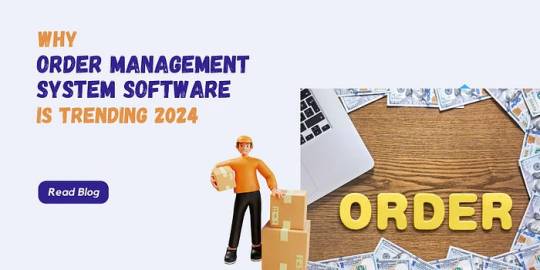
Evolving E-commerce Landscape: The e-commerce market keeps growing, with customers expecting a seamless and efficient shopping experience. OMS helps businesses handle the complexities of online orders, from fulfillment across multiple channels to real-time inventory tracking.
Focus on Customer Experience: Today’s customers demand fast and accurate order fulfillment. OMS software empowers businesses to meet these expectations by optimizing order processing, reducing errors, and providing real-time order tracking.
Rise of Multi-Channel Selling: Businesses are increasingly selling across various channels — online marketplaces, social media platforms, and their own websites. OMS helps manage inventory and orders across these channels, ensuring consistent product availability and a unified customer experience.
Integration with Advanced Technologies: Modern OMS solutions integrate with Artificial Intelligence (AI) and Machine Learning (ML) for features like demand forecasting and automated order routing. This helps businesses optimize inventory levels and fulfillment strategies, leading to increased efficiency and cost savings.
Importance of Data Visibility: In today’s data-driven world, having real-time insights into order fulfillment is crucial. OMS software provides centralized data on inventory levels, order status, and customer information, enabling businesses to make informed decisions and improve their operations.
By implementing an OMS, businesses can stay ahead of the curve in 2024 and beyond, ensuring a smooth and efficient order management process that translates to happy customers and a thriving business.
Market Research of Order Management System Software
Order Management Software Market Size And Forecast

Choosing The Right Order Management Software (OMS)
Here’s a quick rundown of key factors to consider when selecting an OMS for your business:
Business Size and Needs:
#1. Consider the volume of orders you handle and the complexity of your fulfillment process.
#2. Small businesses might prioritize ease-of-use, while larger operations might need advanced features like multi-warehouse management.
Features and Functionalities:
#1. Identify the functionalities crucial for your workflow.
#2. Common features include inventory management, order processing, shipping management, and reporting.
#3. Look for software that caters to your specific needs, like subscriptions for recurring orders or returns management for high-return product categories.
Budget and Scalability:
#1. OMS solutions come in various pricing models.
#2. Factor in your budget and ensure the software can scale alongside your business growth.
#3. Look for solutions offering tiered plans or flexible pricing structures.
Integrations:
#1. Seamless integrations with your existing systems (shopping cart, accounting software, etc.) are crucial for efficient data flow.
#2. Ensure the OMS integrates smoothly with your current tech stack to avoid manual data entry and errors.
By considering these factors, you can choose a custom software development company that specializes in OMS (Order Management System) solutions, streamlining your order management process, improving efficiency, and helping your business thrive.
If you’re looking for an order management system software provider,
Here are some things to consider:
Identify your needs: Make a list of the features and functionalities most important for your business (inventory management, order processing, etc.).
Research OMS vendors: Look for companies with a good reputation and experience in your industry. IBR Infotech offers web development and design services, so they might not specialize in OMS.
Read reviews and compare features: See what other businesses say about different OMS solutions.
Consider a demo: Most OMS vendors offer free demos so you can try out the software before you buy.
Conclusion: Unleash Efficiency with Order Management Software
Imagine a world where order fulfillment runs smoothly, errors are minimized, and customer satisfaction soars. That’s the transformative power of Order Management Software (OMS).
An OMS goes beyond simple order tracking. It acts as a central hub, automating workflows, centralizing inventory data, and streamlining communication across your sales and fulfillment channels. The result? Increased efficiency, reduced costs, and happier customers.
Don’t wait to unlock the potential of OMS! Explore the solutions available and invest in a system that optimizes your order management. Improved efficiency translates to faster order processing, fewer errors, and a significant boost to your bottom line.
Ready to take control? Contact us today for a consultation and discover how OMS software can transform your business. Let’s discuss your specific needs and find the perfect solution to streamline your order management process.
#mobile app development#OMS software#order management#Order Management Software#inventory management#order management system software#custom software development company#warehouse management#Order Management Systems
0 notes
Text
Optimize Your Logistics with Our Cutting-Edge Software Development Service!
Say goodbye to manual hassles and hello to streamlined efficiency with our top-notch Software Development Service for Logistic Management Systems!
With years of experience and a team of dedicated developers, we have successfully transformed logistics operations for numerous clients.
#Logistic Management Systems#Logistics#Transportation#Warehouse#Logistics Software#Software Development#Custom Software#Phoenix#Arizona#USA#PhoenixBizz
0 notes
Text
Warehouse Buzzer System
How Electronic Message Boards Assist In Updating

Electronic message boards are fairly prevalent today, and their usage seems to be proliferating. Message boards in electronic kind properly interact swiftly upgraded company memoranda, final timetable modifications, and marketing, three fairly various applications providing one an idea of the breadth that this medium has gotten to. Herein we explore the phenomenon both generally and in regards to the power released when incorporated with an integrated clock system.
Electronic message boards derive from a lengthy background of open-air communication making use of indicators, billboards, marquees, and so on. Trick attributes were the layouts utilized and the feedback time for updating info. The most usual style entailed drawing on comprehensive personality collections, containing letters, numbers, and spelling, to create words, hanging them from hooks or resting them on wooden slats.
Posts were changed by hand, and updates were thus irregular. In time, updating was improved and somewhat automated using electronic control, such as seen with old baseball park scoreboards.
However, there was still the danger of lacking specific characters and being rendered unable to display all words in your message. This problem was addressed when the dot matrix selection was created, which stood for any type of character (in any type of typeface)-- also graphics-- with a rectangular pattern of on-or-off dots. These could be published on paper, yet a lot more effective was to present them in grids of light bulbs or on a screen.
Mapping formulas converted text into ranges of dots virtually instantaneously, and while drivers entered on a console, messages scrolled across the screen in essentially live. This system still required manual work, however the display screen tool was much easier to read, new, and updatable in a matter of moments. Whence the birth of electronic message boards that utilized light bulbs as the dots, or pixels.
Early light bulbs were incandescent, and were really the only choice; nonetheless, they had brief life-spans and prone to failing from shock. By the millenium, light producing diodes (LED) were a fully grown innovation and available in several shades, including white. Additionally, they outlived incandescent light bulbs by approximately 50 times, were not so breakable, and rapidly came to be the recommended part for message boards.
In time developers got extra creative with the tool and wanted to have more than one "on" shade to deal with. LEDs can fulfill this desire with their 3-in-1 mix of the 3 primary colors to synthesize white light; by choosing different sub-combinations you can obtain 7 various shades.
At some point, upgrading had to transition out of its humble manual origins. Now, textual info can be gotten in real time or gotten from data sources, and software is utilized to map the information right into matrices of (color-coded) dots that get buffered and presented quickly, effortlessly, and effortlessly. Graphics can be incorporated if they are mapped in advance.
Therefore, the modern digital boards are essentially automated, though there are provisions for bypassing scheduled programs with brand-new content in emergencies. Synchronous timekeeping systems manage everything.
An intriguing advancement is the integration of sound signals with the visual information being displayed on a sign in either textual or visual kind. It is popular that a close coordination of both kinds of sensuous stimulations has a tendency to get the message throughout many successfully. It's not a combination of both elements into tune, yet rather the use of sounds (bells, tones, whistles) as focus grabbers to change emphasis of the target market to what the board is showing, whether it be information or other timely information. synchronized clocks for hospitals
The world has actually expanded tired with fixed messaging in regards to both web content and style. Things need to be vibrant to sign up, and this needs constant educational updates. With this article we have seen exactly how electronic message boards promote updating.
youtube
2 notes
·
View notes
Text
Sega Mega Drive - Tetris
Title: Tetris / テトリス
Developer/Publisher: Sega / Sanritsu Denki Co. Ltd. (SIMS Co. Ltd.) / Tengen / Atari Games / Mirrorsoft / Andromeda Software
Release Year: 1989
Catalogue No.: G-4007
Genre: Puzzle

Sega produced a Mega Drive conversion of their hit arcade version in anticipation of being able to win the rights to the home versions from Nintendo in court. The game had been manufactured and was ready to ship, but Sega did not end up winning the legal battle, and they were unable to be sold. The cartridges were left to rot in a warehouse and, ultimately, were presumably destroyed. A handful of copies have, however, found their way into the open market.
More than a decade and a half later, the Mega Drive conversion finally saw official release in 2006 as a bonus in Sega Ages 2500 Series Volume 28 - Tetris Collection.
The Mega Drive version of Tetris is one of the rarest and most sought-after games and the game is honored as such in the 2008 Guinness World Records Gamer's Edition. Less than 10 copies are known to exist. There are, however, numerous bootlegs of Chinese origin floating around.

In August 2010, there was a prototype of the original Mega Drive Tetris for Auction on Yahoo Auctions Japan. The auction went for very little money, in fact only 10,615 yen, which, to put it in perspective, is only a few thousand yen more than a normal retail game for the PS3 or Xbox 360. The winner is indeed a very fortunate chap.
Now, while it can't be said for sure that this proto is 100% legit, although I have no reason to doubt that it is, it can be said that this prototype does indeed carry the code for the official Japanese Tetris cartridge, NOT the hacked Chinese pirate that can be found all over the net and on every Mega Drive Tetris cartridge out there. Just take a look at the screenshots below that I personally took from a Chinese pirate Tetris cartridge and this Prototype.
This is the real title screen as seen on the prototype and official cartridge.
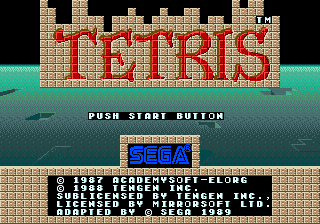
And here is the title screen found on the Chinese fake version, or one of multiple Chinese fake versions of it.
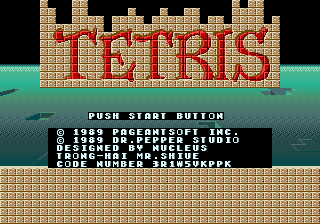
Both of those screenshots were taken from real Mega Drive hardware. Notice how the Chinese fake covers the Sega logo with the copyright information. Not only that, but they've also completely rewritten it as well. Another point about the Chinese fake is that the Sega logo before the title screen appears as a load of blocks, thanks to the pirates scrabbling the graphics code.
So why is the official Mega Drive Tetris so rare? The game was in development alongside the Sega System 16 arcade version and was completed and produced in full. Just before the game was due to be shipped out to retailers, a problem arose with the Tetris license, giving Nintendo exclusive rights to the game. Sega had no choice but to destroy all copies of the Mega Drive Tetris. However, 1 box of games did manage to survive. It's said that there are only 10 official Mega Drive cartridges in existence, making it one of the most sought-after and most expensive games for the system.
Despite the Mega Drive version's legal complications and subsequent cancelled release, bootleg versions of the game quickly found their way onto the unlicensed market, with reports of its availability first appearing in November 1989. Notably, a bootleg copy of Tetris is seen being played in the Jackie Chan action film Police Story 3: Supercop, which began filming around late 1991, demonstrating just how much traction this version had gained in the unlicensed market since then.
Below you can see images of the real official Mega Drive Tetris. This game doesn't belong to me, so please don't ask about it.


And here is the crappy Chinese fake that can be found pretty much anywhere.

youtube
In 2019 with the release of the Mega Drive Mini, the hardware itself came with two bonus games. One a Mega Drive reprogrammed port of Taito's Darius, and a whole new Mega Drive version of Tetris.
The Mega Drive Mini version of Tetris is a more faithful port of the System 16 version of Tetris to the Sega Mega Drive. Unlike the 1989 Mega Drive port, this port was actually licensed.


youtube
2 notes
·
View notes
Text
GIS In Our Daily Lives
The involvement of Geographic Information Systems (GIS) in our daily lives is pervasive, influencing and enhancing various aspects across different sectors. The integration of GIS into everyday activities has become integral for decision-making, planning, and optimizing resources. GIS helps city planners and transportation experts to provide them with information like maps, satellite pictures, population statistics, and infrastructure data. GIS helps them make better decisions when designing cities and transportation systems that are sustainable and good for the environment.
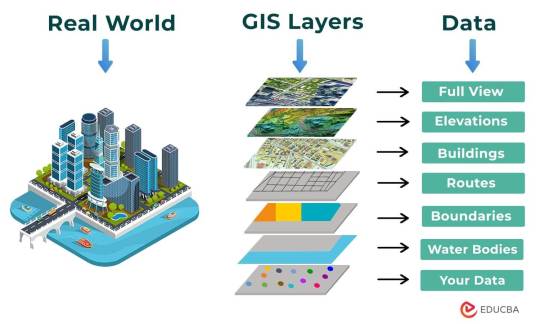
The following points elucidate the notable involvement of GIS in our daily lives:
Navigation and Location Services: GIS provides monitoring functions through the visual display of spatial data and precise geographical positioning of monitored vehicles, whereas GPS provides accurate, clear, and precise information on the position and navigation of a monitored or tracked vehicle in real-time and at the exact location.GIS is at the core of navigation applications and location-based services on smartphones. It enables accurate mapping, real-time navigation, and geolocation services, assisting individuals in finding locations, planning routes, and navigating unfamiliar areas.
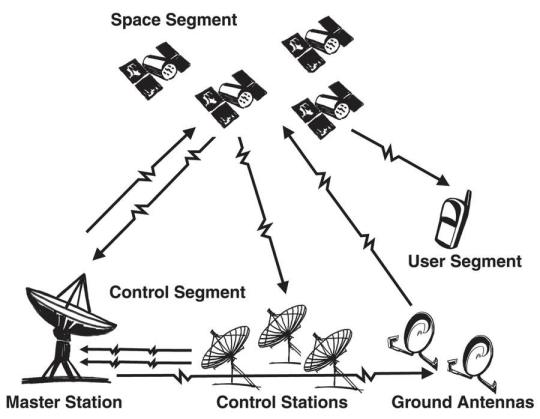
E-Commerce and Delivery Services: GIS software is a powerful tool for supply chain network planning. It helps determine the optimal location for distribution centers, warehouses, or other supply facilities. GIS is utilized in logistics and delivery services for optimizing routes, tracking shipments, and ensuring timely deliveries. E-commerce platforms leverage GIS to enhance the efficiency of their supply chain and last-mile delivery processes.

Weather Forecasting and Disaster Management: Many states are using GIS dashboard to monitor the rainfall across the state, on a real-time basis, from the data shared by rain sensors installed at various locationsGIS plays a crucial role in weather forecasting and disaster management. It assists meteorologists in analyzing spatial data, predicting weather patterns, and facilitating timely responses to natural disasters by mapping affected areas and coordinating emergency services.

Healthcare Planning and Disease Monitoring: Geographic Information Systems enable the visualization and monitoring of infectious diseases. Additionally GIS records and displays the necessary information that health care needs of the community as well as the available resources and materials. GIS supports public health initiatives by mapping the spread of diseases, analyzing healthcare resource distribution, and assisting in the planning of vaccination campaigns. It aids in identifying high-risk areas and optimizing healthcare service delivery.
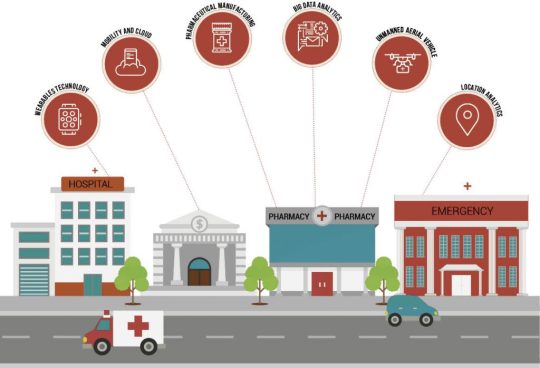
Social Media and Geo-tagging: GIS also helps in geotagging and other location related information in posts, it’s tools can map and visualize the spatial distribution of social media activity. This analysis can reveal trends, hotspots, and patterns in user engagement across different geographic areas. Many social media platforms incorporate GIS for geo-tagging, allowing users to share their location and experiences. This feature enhances social connectivity and facilitates the sharing of location-specific information.
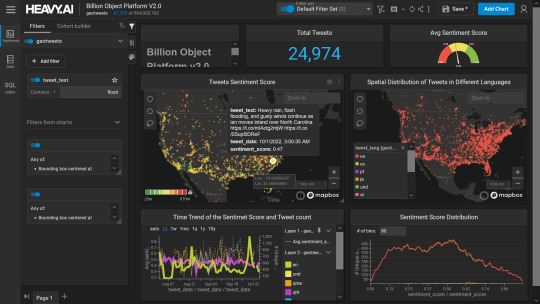
Smart City Initiatives: The Geographic Information System (GIS) offers advanced and user-friendly capabilities for Smart City projects and allows to capture, store and manipulate, analyze and visualize spatially referenced data. It is used for spatial analysis and modeling. It is the cornerstone of smart city planning, enabling the integration of data for efficient urban management. It supports initiatives related to traffic management, waste disposal, energy consumption, and overall infrastructure development.

Education and Research: GIS is increasingly utilized in education and research for visualizing and analyzing spatial data. It enables students and researchers to explore geographic relationships, conduct field studies, and enhance their understanding of various subjects.

Agricultural Management and Precision Farming: Farmers leverage GIS to optimize agricultural practices by analyzing soil conditions, crop health, and weather patterns. Precision farming techniques, facilitated by GIS, contribute to increased crop yields and sustainable farming practices.

Real Estate and Property Management: In the real estate sector, GIS aids in property mapping, land valuation, and site selection. It provides real estate professionals with valuable insights into spatial relationships, market trends, and optimal development opportunities.
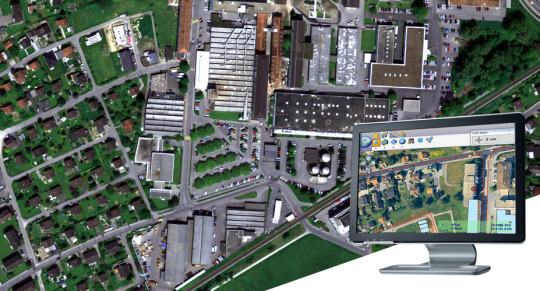
Tourism and Recreation: GIS enhances the tourism industry by providing interactive maps, route planning, and location-based information. It assists tourists in exploring destinations, finding attractions, and navigating efficiently.

The broad and varied involvement of GIS in our daily lives underscores its significance as a technology that not only facilitates geographic data analysis but also contributes to the efficiency, safety, and interconnectedness of modern society. As GIS applications continue to evolve, their impact on daily activities is expected to further expand and refine.
#gis#architectdesign#architecture#city#education#geographic information system(gis)#geographical indication
14 notes
·
View notes
Link
Credit: NASA New space technology ideas emerge every day from innovators across the country, and NASA’s Small Business Innovation Research (SBIR) program on Monday selected more than 100 projects for funding. This program offers small businesses in the United States early-stage funding and support to advance the agency’s goals of exploring the unknown in air and space while returning benefits to Earth. Specifically, NASA’s SBIR program awarded $93.5 million in Phase II contracts to bring 107 new ideas to life from 95 selected small businesses. Of these businesses, nearly 80% have less than 50 employees, and 21% are receiving their first Phase II award, valued at up to $850,000 each. Each small business was also eligible to apply for up to $50,000 in Technical and Business Assistance program funding to help find new market opportunities and shape their commercialization roadmap. “We are thrilled to support this diverse set of companies as they work diligently to bring their technologies to market,” said Jenn Gustetic, director of Early Stage Innovation and Partnerships with NASA’s Space Technology Mission Directorate (STMD) at the agency’s headquarters in Washington. “Inclusive innovation is integral to mission success at NASA, and we’re excited to see that 29% of the awardees are from underrepresented groups, including 11% women-owned businesses.” In Phase II, awardees will build on their success from the program’s first phase to bring their technologies closer to real-world use. The companies have 24 months to execute their plans, which focus on their technologies’ path to commercialization. For example, NASA selected women-owned and first-time NASA Phase II awardee nou Systems, Inc. in Huntsville, Alabama, for its genetic testing instrument. While portable genetic sequencing already exists, field sequencing – that would allow DNA analysis anywhere on Earth or off planet – remains unfeasible as the preparation of the DNA Library remains an intensely manual process, needing a trained wet lab technician and several pieces of laboratory equipment. The Phase II technology takes advantage of several cross-enabling technologies, creating an instrument to automate the genetic sequencing process. “Our program works directly with small businesses to forge innovative concepts and technologies that drive impact for NASA projects as well as a myriad of commercial endeavors,” said Jason L. Kessler, program executive for NASA’s SBIR and Small Business Technology Transfer (STTR) program at NASA Headquarters. “This collaboration results in realized opportunities not only for NASA but all of humanity.” This includes technologies aiming to reduce astronaut workload and improve robotic scientific endeavors on the Moon and Mars. PickNik Inc. based in Boulder, Colorado, will use its Phase II award to continue developing a hardware-agnostic platform for supervised autonomy that empowers humans to command a remote robot to complete complex tasks with minimal input, which could support the Artemis program. Outside of NASA, PickNik’s software product may be of interest to commercial space customers working on low Earth orbit destinations, in-space servicing, and more, as well as on Earth in areas like warehouse management, oil rig maintenance, and deep-sea exploration. The NASA SBIR program is open to U.S. small businesses to develop an innovation or technology. The program is part of STMD and managed by NASA’s Ames Research Center in California’s Silicon Valley. To learn more about the NASA SBIR program, visit: https://sbir.nasa.gov -end- Jimi RussellHeadquarters, [email protected] Share Details Last Updated Apr 22, 2024 LocationNASA Headquarters Related TermsSmall Business Innovation Research / Small BusinessSpace Technology Mission Directorate
2 notes
·
View notes
Text
Data Engineering Concepts, Tools, and Projects
All the associations in the world have large amounts of data. If not worked upon and anatomized, this data does not amount to anything. Data masterminds are the ones. who make this data pure for consideration. Data Engineering can nominate the process of developing, operating, and maintaining software systems that collect, dissect, and store the association’s data. In modern data analytics, data masterminds produce data channels, which are the structure armature.
How to become a data engineer:
While there is no specific degree requirement for data engineering, a bachelor's or master's degree in computer science, software engineering, information systems, or a related field can provide a solid foundation. Courses in databases, programming, data structures, algorithms, and statistics are particularly beneficial. Data engineers should have strong programming skills. Focus on languages commonly used in data engineering, such as Python, SQL, and Scala. Learn the basics of data manipulation, scripting, and querying databases.
Familiarize yourself with various database systems like MySQL, PostgreSQL, and NoSQL databases such as MongoDB or Apache Cassandra.Knowledge of data warehousing concepts, including schema design, indexing, and optimization techniques.
Data engineering tools recommendations:
Data Engineering makes sure to use a variety of languages and tools to negotiate its objects. These tools allow data masterminds to apply tasks like creating channels and algorithms in a much easier as well as effective manner.
1. Amazon Redshift: A widely used cloud data warehouse built by Amazon, Redshift is the go-to choice for many teams and businesses. It is a comprehensive tool that enables the setup and scaling of data warehouses, making it incredibly easy to use.
One of the most popular tools used for businesses purpose is Amazon Redshift, which provides a powerful platform for managing large amounts of data. It allows users to quickly analyze complex datasets, build models that can be used for predictive analytics, and create visualizations that make it easier to interpret results. With its scalability and flexibility, Amazon Redshift has become one of the go-to solutions when it comes to data engineering tasks.
2. Big Query: Just like Redshift, Big Query is a cloud data warehouse fully managed by Google. It's especially favored by companies that have experience with the Google Cloud Platform. BigQuery not only can scale but also has robust machine learning features that make data analysis much easier. 3. Tableau: A powerful BI tool, Tableau is the second most popular one from our survey. It helps extract and gather data stored in multiple locations and comes with an intuitive drag-and-drop interface. Tableau makes data across departments readily available for data engineers and managers to create useful dashboards. 4. Looker: An essential BI software, Looker helps visualize data more effectively. Unlike traditional BI tools, Looker has developed a LookML layer, which is a language for explaining data, aggregates, calculations, and relationships in a SQL database. A spectacle is a newly-released tool that assists in deploying the LookML layer, ensuring non-technical personnel have a much simpler time when utilizing company data.
5. Apache Spark: An open-source unified analytics engine, Apache Spark is excellent for processing large data sets. It also offers great distribution and runs easily alongside other distributed computing programs, making it essential for data mining and machine learning. 6. Airflow: With Airflow, programming, and scheduling can be done quickly and accurately, and users can keep an eye on it through the built-in UI. It is the most used workflow solution, as 25% of data teams reported using it. 7. Apache Hive: Another data warehouse project on Apache Hadoop, Hive simplifies data queries and analysis with its SQL-like interface. This language enables MapReduce tasks to be executed on Hadoop and is mainly used for data summarization, analysis, and query. 8. Segment: An efficient and comprehensive tool, Segment assists in collecting and using data from digital properties. It transforms, sends, and archives customer data, and also makes the entire process much more manageable. 9. Snowflake: This cloud data warehouse has become very popular lately due to its capabilities in storing and computing data. Snowflake’s unique shared data architecture allows for a wide range of applications, making it an ideal choice for large-scale data storage, data engineering, and data science. 10. DBT: A command-line tool that uses SQL to transform data, DBT is the perfect choice for data engineers and analysts. DBT streamlines the entire transformation process and is highly praised by many data engineers.
Data Engineering Projects:
Data engineering is an important process for businesses to understand and utilize to gain insights from their data. It involves designing, constructing, maintaining, and troubleshooting databases to ensure they are running optimally. There are many tools available for data engineers to use in their work such as My SQL, SQL server, oracle RDBMS, Open Refine, TRIFACTA, Data Ladder, Keras, Watson, TensorFlow, etc. Each tool has its strengths and weaknesses so it’s important to research each one thoroughly before making recommendations about which ones should be used for specific tasks or projects.
Smart IoT Infrastructure:
As the IoT continues to develop, the measure of data consumed with high haste is growing at an intimidating rate. It creates challenges for companies regarding storehouses, analysis, and visualization.
Data Ingestion:
Data ingestion is moving data from one or further sources to a target point for further preparation and analysis. This target point is generally a data storehouse, a unique database designed for effective reporting.
Data Quality and Testing:
Understand the importance of data quality and testing in data engineering projects. Learn about techniques and tools to ensure data accuracy and consistency.
Streaming Data:
Familiarize yourself with real-time data processing and streaming frameworks like Apache Kafka and Apache Flink. Develop your problem-solving skills through practical exercises and challenges.
Conclusion:
Data engineers are using these tools for building data systems. My SQL, SQL server and Oracle RDBMS involve collecting, storing, managing, transforming, and analyzing large amounts of data to gain insights. Data engineers are responsible for designing efficient solutions that can handle high volumes of data while ensuring accuracy and reliability. They use a variety of technologies including databases, programming languages, machine learning algorithms, and more to create powerful applications that help businesses make better decisions based on their collected data.
4 notes
·
View notes
Text
Construction Company In Hyderabad | Urban Build

In the rapidly expanding cityscape of Hyderabad, the demand for dependable and quality-driven construction services has soared to unprecedented heights. Whether it's a modern residential villa, a commercial complex, or a sustainable smart building, everyone is searching for a name they can trust. Enter Urban Build, the go-to construction company in Hyderabad that’s reshaping skylines and turning architectural dreams into reality.
Understanding the Urban Expansion in Hyderabad
Hyderabad, the Pearl City, is no longer just a historical and cultural hub. Over the past decade, it has transformed into a high-tech metropolis buzzing with innovation, IT parks, infrastructure projects, and smart city initiatives. As people migrate from across India for work and better living standards, the need for well-planned housing and commercial infrastructure is more important than ever.
This development boom has naturally increased the demand for reliable construction partners. However, not every builder or contractor in the region offers the same level of professionalism, innovation, or integrity. That’s where Urban Build shines—an industry leader that delivers on all fronts.
What Sets Urban Build Apart?
As a premier construction company in Hyderabad, Urban Build prides itself on a foundation of quality, transparency, and timely delivery. We don’t just build structures—we create environments that enhance quality of life and offer lasting value.
1. Expertise Across Multiple Construction Domains
From gated community villas and luxury apartments to office buildings and warehouses, Urban Build has mastered it all. Our portfolio spans:
Residential Projects: Affordable apartments, duplex houses, and luxury villas.
Commercial Spaces: Office complexes, retail shops, and hospitality buildings.
Custom Projects: From religious structures to industrial sheds.
With every project, we employ best-in-class construction practices and top-grade materials to ensure durability and safety.
2. End-to-End Solutions
What truly sets Urban Build apart is our ability to offer end-to-end solutions. We’re not just builders—we are your project partners from concept to completion. Our services include:
Architectural Design
Structural Engineering
Project Management
Legal Clearances and Approvals
Budget Planning and Cost Control
Quality Assurance and Post-Construction Support
This comprehensive approach means you don’t have to juggle multiple vendors. Urban Build handles everything under one roof, ensuring a stress-free experience.
3. Transparent and Ethical Practices
One of the biggest concerns customers have with any construction company in Hyderabad is transparency. At Urban Build, honesty is the core of our business ethics. From detailed cost estimates and milestone-based payments to regular project updates and site visits, we keep you informed every step of the way.
Why Hyderabad Chooses Urban Build
In a city filled with builders and developers, Urban Build stands out for its customer-centric approach. Here’s why homeowners, investors, and businesses consistently choose us:
A. Customized Designs That Match Your Vision
We understand that every client is unique, and so is their dream. Our in-house architects work closely with you to translate your ideas into detailed blueprints. Whether it’s a minimalist 2BHK or a grand 5BHK villa with landscape gardens, we deliver exactly what you imagine—if not better.
B. Use of Latest Construction Technologies
Urban Build integrates modern construction technologies such as:
Precast concrete systems
Advanced curing methods
Environment-friendly building materials
3D modeling and BIM software
Smart home automation integrations
These innovations help us deliver faster turnaround times and high-precision execution while reducing long-term maintenance costs.
C. Eco-Friendly and Sustainable Practices
With growing awareness of environmental impact, more clients are seeking eco-conscious solutions. Urban Build is a pioneer in green building technologies. We:
Use fly ash and sustainable bricks
Implement rainwater harvesting systems
Design structures for maximum natural lighting
Incorporate solar panels and energy-saving devices
This makes us a preferred construction company in Hyderabad for clients who care about the planet.
Our Project Execution Process
To ensure flawless execution and client satisfaction, Urban Build follows a rigorous 6-stage construction methodology:
1. Consultation & Planning
Understanding your needs, goals, and budget to create a personalized plan.
2. Design & Approval
Conceptualizing the architecture, structural designs, and getting necessary legal approvals.
3. Material Selection & Procurement
Sourcing only the highest-quality materials from verified suppliers.
4. Construction Phase
A dedicated project team ensures quality checks at every milestone.
5. Interior & Utility Setup
Final fittings, electricals, plumbing, and modular installations.
6. Handover & Support
On-time delivery with documentation and post-handover maintenance support.
This structured approach allows Urban Build to ensure that each project is completed with precision, within budget, and on time.
Costing and Budget Transparency
One common worry in the construction industry is hidden charges or escalating costs. At Urban Build, we believe your peace of mind comes first. We provide a detailed cost estimate that includes:
Foundation and structure cost
Electrical and plumbing cost
Finishing and interior work
Permit and approval fees
Contingency budget buffer
We maintain full transparency and provide regular expense updates so you can track every rupee.
Future-Ready Vision with Urban Build
At Urban Build, our goal is not just to be a leading construction company in Hyderabad today but to pave the path for future-ready, smart, and sustainable structures that can withstand time. We are constantly upgrading our skills, adopting new technologies, and staying ahead of market trends to deliver unmatched excellence.
Upcoming Innovations We’re Working On:
AI-based construction monitoring
Drones for site inspections
Zero-energy building prototypes
Vertical and modular construction solutions
These initiatives underline our commitment to future-proofing your investments.
Service Areas
Urban Build operates across all major zones of Hyderabad, including but not limited to:
Hitec City
Gachibowli
Kukatpally
LB Nagar
Uppal
Banjara Hills
Madhapur
Miyapur
Kompally
Shamshabad
So wherever you are in Hyderabad, Urban Build is just a call away.
How to Get Started
Starting your construction journey with Urban Build is as simple as:
Reach Out: Contact us through our website or phone for an initial consultation.
Schedule a Site Visit: We inspect the location and discuss requirements.
Get a Quote: Receive a detailed proposal with timeline and budget.
Plan & Build: Watch your dream take shape with regular updates from our team.
Final Thoughts: Build Your Vision with Urban Build
When it comes to choosing a reliable and professional construction company in Hyderabad, Urban Build is a name you can count on. From first brick to final polish, we bring unmatched passion, precision, and performance to every project we undertake.
If you're ready to build your dream home or commercial space, partner with Urban Build—where integrity meets innovation.
CONTACT US;
+91 7095992159
EMAIL ID;
Address;
Plot no 74,75, Akshitha Residency, Sai Balaji enclave, Mallampet, Bachupally, Telangana, 502303.
#building construction company in hyderabad#construction company in hyderabad#home construction companies in hyderabad
0 notes
Text
KhaataPro: The Ultimate Billing & Accounting Solution for Indian Business
In the digital transformation era, small and medium enterprises (SMEs) across India are seeking efficient, affordable, and comprehensive billing solutions that can streamline their financial operations. Khaata Pro emerges as a game-changing billing and accounting software, specifically designed and developed in India to address the unique needs of Indian businesses. Set to launch on June 26, 2025, this all-in-one finance management solution promises to revolutionize how SMEs handle their billing, accounting, and inventory management processes.
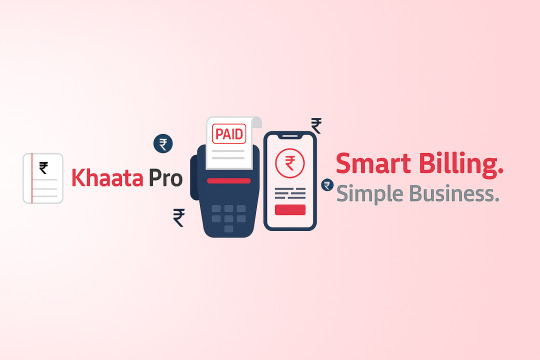
What is KhaataPro?
Khaata Pro is a comprehensive billing and accounting software that serves as an all-in-one finance management system. Designed with Indian SMEs in mind, this versatile platform combines billing, accounting, and inventory management capabilities into a single, user-friendly interface. The software is accessible on both mobile and desktop platforms, ensuring businesses can maintain control over their financial operations anytime, anywhere.
The platform addresses the critical need for GST-compliant billing solutions while offering advanced features that go beyond basic invoicing. Khaata Pro represents a shift from manual record-keeping to automated, professional financial management for businesses of all sizes.
Core Features and Capabilities
System Infrastructure
Khaata Pro offers robust core system features including synchronization capabilities, offline access functionality, multi-company support, and integrated E-Way Bill generation. These foundational features ensure that businesses can operate efficiently regardless of internet connectivity or organizational complexity.
Invoicing and Billing Excellence
The software enables businesses to create personalized GST invoices that reflect their brand identity and values. Key invoicing features include customizable invoice templates, credit limit management, bulk printing capabilities, and professional branding options. The platform ensures all invoices are GST-compliant while maintaining a sleek, professional appearance that leaves lasting impressions on clients.
Point of Sale (POS) Integration
Khaata Pro features a touch-friendly POS billing interface designed for quick retail operations. This functionality is particularly valuable for retail shops and businesses requiring fast, efficient customer service at the point of sale.
Inventory Management System
The comprehensive inventory management module includes wholesale pricing capabilities, barcode generation and printing, and advanced godown (warehouse) management. These features help businesses maintain accurate stock levels, optimize pricing strategies, and streamline warehouse operations.
Purchase Management
Advanced purchase management features include purchase order creation, automatic receipt scanning, and comprehensive vendor management. These capabilities help businesses maintain efficient supply chain operations and accurate financial records.
Staff and User Management
The software includes sophisticated user role management, permission settings, and activity tracking capabilities. This ensures proper access control and accountability across different team members and departments.
Communication Integration
Khaata Pro incorporates WhatsApp integration for seamless communication and marketing capabilities. This feature enables businesses to send invoices, payment reminders, and marketing messages directly through WhatsApp, enhancing customer engagement and improving cash flow management.
Configuration and Customization
The platform offers extensive customization options including custom fields, TDS (Tax Deducted at Source) and TCS (Tax Collected at Source) management, support for multiple firms, multi-language capabilities, and comprehensive backup solutions.
Reports and Analytics
Comprehensive reporting capabilities provide insights into sales performance, inventory levels, and overall financial health. These analytics help business owners make informed decisions and track their company's growth trajectory.
Target Audience and Applications
Khaata Pro is designed to serve a wide range of business types and professionals:
Small Business Owners can leverage the comprehensive feature set to manage all aspects of their financial operations from a single platform.
Freelancers and Consultants benefit from professional invoicing capabilities and client management features.
Large Enterprises can utilize the multi-company support and advanced user management features for complex organizational structures.
Accounting and Finance Teams gain access to comprehensive reporting and compliance features that streamline financial management processes.
Advantages and Benefits
Professional Brand Presentation
KhaataPro enables businesses to create branded, professional invoices that reflect their identity and values. This professional presentation helps businesses stand out from competitors and maintain credibility with clients.
Enhanced Cash Flow Management
The integrated payment reminder system and comprehensive invoice tracking help businesses improve their cash flow by reducing outstanding dues and ensuring timely payments.
Compliance and Accuracy
Built-in GST compliance features ensure that all invoices and financial records meet Indian tax regulations, reducing the risk of compliance issues and penalties.
Security and Data Protection
Understanding the critical importance of business data security, KhaataPro implements multiple layers of protection. The software uses advanced data encryption, provides automatic backup capabilities, and follows strong security practices to protect against unauthorized access and data loss.
Future Outlook and Impact
The launch of KhaataPro represents more than just another software release; it signifies a commitment to empowering Indian SMEs with the tools they need to compete effectively in the digital economy. By providing affordable access to professional billing and accounting capabilities, KhaataPro has the potential to significantly impact how small businesses across India manage their financial operations.
Conclusion
KhaataPro emerges as a comprehensive solution for Indian SMEs seeking professional billing and accounting software. With its extensive feature set, user-friendly design, and specific focus on Indian business needs, the platform promises to transform how small and medium enterprises manage their financial operations.
For SMEs looking to move beyond manual record-keeping and embrace digital transformation, KhaataPro provides a compelling solution that combines functionality, affordability, and ease of use. As Indian businesses continue to evolve and grow, platforms like Khaata Pro will play a crucial role in supporting their success and contributing to the country's economic development.
0 notes
Text
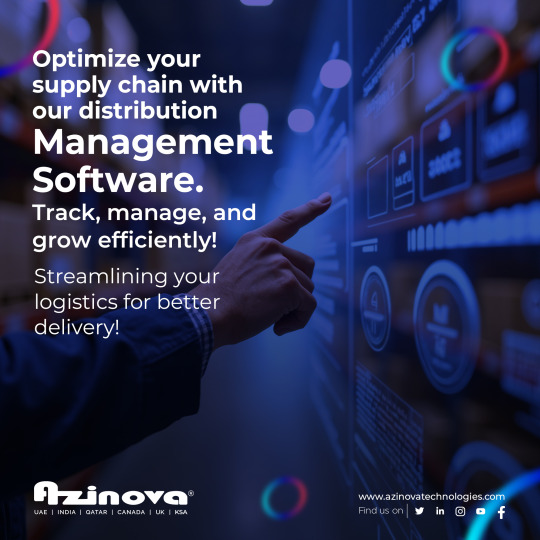
Streamline your business operations and improve supply chain performance with our innovative Distribution Management System Software. Efficient tracking, management, and growth made simple.
#Document Management System#Document Management System Dubai#Document Management Software#supply chain management software Dubai#ERP Development Company Dubai#odoo ERP software Dubai#odoo erp solution in dubai#odoo ERP in dubai#warehouse management software Dubai#Best Warehouse Management Software Dubai#odoo partner dubai#odoo software development
0 notes
Text
Professional Fire System Maintenance in Singapore | Keep Your Building Safe
Fire safety is not just a regulatory mandate—it's a fundamental responsibility for any building owner or manager. If you're a commercial building owner or manager, industrial plant manager, or residential complex manager, it's critical that your fire protection systems are maintained in good working condition. That's where fire system maintenance in Singapore comes into play.
Why Fire System Maintenance in Singapore Matters
Singapore's strict reputation for fire safety is sustained by SCDF (Singapore Civil Defence Force). Protection systems against fires should be installed and kept according to code in buildings. The failure to comply with this not only attracts penalties but also threatens life and property.
Routine fire system maintenance in Singapore prevents faults from developing into a crisis. It keeps your fire alarms, sprinkler systems, hosereels, extinguishers, and detectors operating at optimum performance—day or night, rain or shine.
What is Included in Fire System Maintenance?
An average fire system maintenance in Singapore would involve:
Fire alarm and control panel checks
Sprinkler head and pressure valve tests
Fire hosereel and hydrant servicing
Fire extinguisher checks and refills
Having all of the system indicators and emergency lights functioning
These units work together to provide a full layer of fire protection. If one fails, the risk is significantly increased. That is why Singapore professional fire system maintenance must be scheduled regularly and done by skilled technicians.
How Often Should You Schedule Fire System Maintenance
Singapore's SCDF recommends quarterly, half-yearly, or annual maintenance based on system type. Specialist contractors strictly follow these regulations to maintain your building in compliance and safety.
Singapore fire system regular maintenance not only detects hardware faults but also whether software upgrades and panel settings are correct. This can prove to be priceless in integrated fire alarm and BMS (Building Management System) installations.
Who Needs Fire System Maintenance in Singapore?
The quick answer? Anyone. If you've got fire protection devices in your premises, you need fire system maintenance in Singapore. These include:
Commercial offices
Shopping malls and retail stores
F&B stores and central kitchens
Schools and universities
Warehouses and logistics warehouses
Condominiums and HDBs
Industrial factories and manufacturing plants
Many quality firms such as drakofire have been holding a varied portfolio of such premises. Their trained professionals deliver compliance, reduce downtime, and bring peace of mind.
Warning Signs of Instant Maintenance
In some cases, buildings forego maintenance when already too late. Keep an eye out for these warning signs:
Unwarranted triggering of fire alarms
Leaky or rusty sprinkler heads
Fire extinguishers with outdated dates
Non-functional emergency lights or alarm panels
Interference with fire exit or hosereels
Any of these warning signs indicate that your Singapore fire system maintenance is overdue. Taking swift action will prevent damage, injury, or even death.
Advantages of Professional Singapore Fire System Maintenance
In professional work, Singapore fire system maintenance offers several vital benefits:
Compliance with the law:
Remain in compliance with SCDF codes and regulations and prevent fines.
1. Validity of insurance:
Insurers will ask for valid maintenance records from you.
2. Equipment long-term:
Extend the life of your fire systems.
3.Emergency response fast:
Work correctly in emergency conditions.
4.Peace of mind:
Ensure your property is prepared and safe.
Having trusted service experts like drakofire can make this easier. They possess experienced technicians, advanced testing machines, and compliant procedures to make certain that your systems are always operating properly.
Fire System Maintenance & SCDF Submissions
Another reason fire system maintenance in Singapore is essential is its connection to SCDF submissions. When upgrading or altering systems, updated testing and certification are often needed. Regular servicing ensures you’re ready to submit documentation without scrambling for last-minute repairs or tests.
Tips for Choosing the Right Maintenance Partner
To get the most out of your fire system maintenance in Singapore, work with licensed, experienced providers. Here’s what to look for:
SCDF-approved contractor
Clear service checklist
Transparent reporting and inspection logs
Emergency call-out availability
Knowledge of local building types and risks
Companies like drakofire are known to tick all these boxes, and thus emerge as a trustworthy name in the industry.
Final Thoughts
Fire protection isn't something you do once—you do it repeatedly. With Singapore fire system maintenance services, you ensure your building is safe, your people are safe, and your operations never stand exposed.
Don't wait until a fire emergency to realize the importance of maintenance. Schedule your future fire system maintenance in Singapore today, and take a proactive path towards safety, compliance, and peace of mind that endures.
0 notes
Text
In the rapidly evolving landscape of modern business, the imperative for digital transformation has never been more pronounced, driven by the relentless pressures of competition. Central to this transformational journey is the strategic utilization of data, which serves as a cornerstone for gaining insights and facilitating predictive analysis. In effect, data has assumed the role of a contemporary equivalent to gold, catalyzing substantial investments and sparking a widespread adoption of data analytics methodologies among businesses worldwide. Nevertheless, this shift isn't without its challenges. Developing end-to-end applications tailored to harness data for generating core insights and actionable findings can prove to be time-intensive and costly, contingent upon the approach taken in constructing data pipelines. These comprehensive data analytics applications, often referred to as data products within the data domain, demand meticulous design and implementation efforts. This article aims to explore the intricate realm of data products, data quality, and data governance, highlighting their significance in contemporary data systems. Additionally, it will explore data quality vs data governance in data systems, elucidating their roles and contributions to the success of data-driven initiatives in today's competitive landscape. What are Data Products? Within the domain of data analytics, processes are typically categorized into three distinct phases: data engineering, reporting, and machine learning. Data engineering involves ingesting raw data from diverse sources into a centralized repository such as a data lake or data warehouse. This phase involves executing ETL (extract, transform, and load) operations to refine the raw data and then inserting this processed data into analytical databases to facilitate subsequent analysis in machine learning or reporting phases. In the reporting phase, the focus shifts to effectively visualizing the aggregated data using various business intelligence tools. This visualization process is crucial for uncovering key insights and facilitating better data-driven decision-making within the organization. By presenting the data clearly and intuitively, stakeholders can derive valuable insights to inform strategic initiatives and operational optimizations. Conversely, the machine learning phase is centered around leveraging the aggregated data to develop predictive models and derive actionable insights. This involves tasks such as feature extraction, hypothesis formulation, model development, deployment to production environments, and ongoing monitoring to ensure data quality and workflow integrity. In essence, any software service or tool that orchestrates the end-to-end pipeline—from data ingestion and visualization to machine learning—is commonly referred to as a data product, serving as a pivotal component in modern data-driven enterprises. At this stage, data products streamline and automate the entire process, making it more manageable while saving considerable time. Alongside these efficiencies, they offer a range of outputs, including raw data, processed-aggregated data, data as a machine learning service, and actionable insights. What is Data Quality? Data quality refers to the reliability, accuracy, consistency, and completeness of data within a dataset or system. It encompasses various aspects such as correctness, timeliness, relevance, and usability of the data. In simpler terms, data quality reflects how well the data represents the real-world entities or phenomena it is meant to describe. High-quality data is free from errors, inconsistencies, and biases, making it suitable for analysis, decision-making, and other purposes. The Mission of Data Quality in Data Products In the realm of data products, where decisions are often made based on insights derived from data, ensuring high data quality is paramount. The mission of data quality in data products is multifaceted.
First and foremost, it acts as the foundation upon which all subsequent analyses, predictions, and decisions are built. Reliable data fosters trust among users and stakeholders, encourages the adoption and utilization of data products, and drives innovation, optimization, and compliance efforts. Moreover, high-quality data enables seamless integration, collaboration, and interoperability across different systems and platforms, maximizing the value derived from dataasset What is Data Governance? Data governance is the framework, policies, procedures, and practices that organizations implement to ensure the proper management, usage, quality, security, and compliance of their data assets. It involves defining roles, responsibilities, and decision-making processes related to data management, as well as establishing standards and guidelines for data collection, storage, processing, and sharing. Data governance aims to optimize the value of data assets while minimizing risks and ensuring alignment with organizational objectives and regulatory requirements. The Mission of Data Governance in Data Products In data products, data governance ensures accountability, transparency, and reliability in data management. It maintains data quality and integrity, fostering trust among users. Additionally, data governance facilitates compliance with regulations, enhances data security, and promotes efficient data utilization, driving organizational success through informed decision-making and collaboration. By establishing clear roles, responsibilities, and standards, data governance provides a structured framework for managing data throughout its lifecycle. This framework mitigates errors and inconsistencies, ensuring data remains accurate and usable for analysis. Furthermore, data governance safeguards against data breaches and unauthorized access, while also enabling seamless integration and sharing of data across systems, optimizing its value for organizational objectives. Data Quality vs. Data Governance: A Brief Comparison Data quality focuses on the accuracy, completeness, and reliability of data, ensuring it meets intended use requirements. It guarantees that data is error-free and suitable for analysis and decision-making. Data governance, meanwhile, establishes the framework, policies, and procedures for managing data effectively. It ensures data is managed securely, complies with regulations, and aligns with organizational goals. In essence, data quality ensures the reliability of data, while data governance provides the structure and oversight to manage data effectively. Both are crucial for informed decision-making and organizational success. Conclusion In summary, data quality and data governance play distinct yet complementary roles in the realm of data products. While data quality ensures the reliability and accuracy of data, data governance provides the necessary framework and oversight for effective data management. Together, they form the foundation for informed decision-making, regulatory compliance, and organizational success in the data-driven era.
0 notes
Text
RFID Definition: 5 Key Facts & Uses of RFID Technology
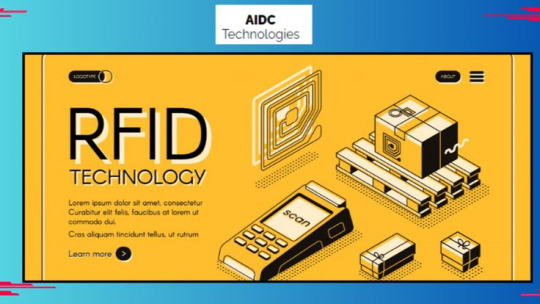
In today’s fast-paced business world, companies across sectors are turning to smart technologies to stay competitive. Among the most useful innovations is RFID technology. The term RFID stands for Radio Frequency Identification, and understanding the RFID Definition is key to unlocking the benefits it offers. In 2025, RFID is more than just a buzzword—it’s an operational game-changer.
AIDC Technologies India is a leading provider of RFID systems that help companies track assets, manage inventory, and improve efficiency. Whether you’re in logistics, healthcare, or retail, understanding the RFID Definition will help you use this technology effectively. This guide will walk you through six quick facts about RFID, why it matters, and how AIDC supports businesses in applying it in real-world settings.
RFID Stands for Radio Frequency Identification
The first and most basic part of understanding the RFID Definition is to know what it stands for—Radio Frequency Identification. This technology uses radio waves to automatically identify and track tags attached to objects. These tags contain data that is read by RFID readers, and the information is then processed by RFID software.
Unlike traditional barcodes, RFID does not need a direct line of sight to work. Tags can be read through containers, walls, or packaging. AIDC Technologies India helps businesses set up complete RFID systems, including readers, tags, antennas, and integration services, to ensure fast, reliable identification.
RFID Tags Come in Multiple Forms
Another key component of the RFID Definition is the RFID tag. There are three main types: passive, active, and semi-passive. Passive tags don’t have a power source and rely on the reader’s signal to activate. They’re commonly used in retail and asset management. Active tags have their own battery and can transmit signals over longer distances—ideal for tracking high-value or mobile assets. Semi-passive tags combine features of both.
AIDC India provides a wide range of RFID tags to meet specific needs. Whether you’re managing a warehouse or tracking medical devices, AIDC’s experts help you choose the right tag for your application.
RFID Enhances Real-Time Asset Tracking
A major benefit included in the RFID Definition is real-time tracking. RFID systems allow companies to see exactly where an item is at any given moment. This is especially valuable in logistics and supply chains where timely delivery is critical.
With RFID systems from AIDC Technologies India, you can track movement, monitor usage, and even detect anomalies in real time. This level of visibility improves planning, reduces loss, and enhances overall productivity. RFID also helps companies make better business decisions based on accurate, up-to-date data.
RFID Systems Are Scalable and Cost-Effective
The RFID Definition also covers the flexibility and scalability of these systems. Whether you are a small retail outlet or a large manufacturing plant, RFID can be tailored to fit your operations. You can start small—with a few tagged items—and expand the system as your needs grow.
AIDC Technologies India offers scalable RFID systems designed to grow with your business. Their solutions are also cost-effective, helping you reduce labor costs, prevent theft, and improve accuracy. With AIDC, the transition to RFID doesn’t require a massive investment and delivers long-term returns.
RFID Is Transforming Multiple Industries
The RFID Definition applies across a wide range of industries. In retail, it helps track products from warehouse to shelf. In healthcare, it ensures patient safety and medical inventory accuracy. In logistics, it manages fleet tracking, warehouse operations, and real-time delivery updates.
AIDC Technologies India develops industry-specific RFID systems that solve real-world problems. Their expertise ensures smooth implementation and long-term support. Whether it’s controlling stock, preventing loss, or improving operational workflows, AIDC brings the RFID Definition to life across every sector they serve.
RFID Offers Contactless & Accurate Data Capture
An essential part of the RFID Definition is its contactless functionality. RFID readers can scan multiple tags at once without physical contact. This leads to faster, more accurate data collection—critical in busy environments like warehouses or hospitals.
AIDC India provides RFID systems that eliminate manual errors and speed up operations. No more scanning one item at a time. With RFID, entire batches can be scanned instantly. This leads to better resource management, quicker inventory audits, and higher employee productivity.
Why Choose AIDC Technologies India for RFID Implementation
If you're exploring RFID for the first time, understanding the RFID Definition is just the start. Implementing it successfully requires the right technology and expert guidance. AIDC Technologies India offers both. From consultation to deployment, AIDC delivers turnkey RFID systems customized to meet your unique business needs.
With years of experience and a deep understanding of industry standards, AIDC ensures that every component—hardware, software, and integration—works seamlessly. Their solutions are designed to be user-friendly, scalable, and aligned with your operational goals.
When you partner with AIDC, you're not just getting RFID products. You're getting a reliable partner that ensures your RFID systems perform effectively from day one.
Conclusion: Power Your Business with RFID in 2025
In 2025, the RFID Definition is no longer limited to technical jargon—it’s a crucial part of business success. From tracking goods in real time to reducing operational errors, RFID is a tool every business should consider. As more industries shift toward smart tracking, now is the perfect time to explore RFID and understand how it can work for you.
AIDC Technologies India stands at the forefront of this transformation. With its expertise, scalable solutions, and industry-focused approach, AIDC helps organizations make the most of RFID technology. If you’re ready to move beyond manual tracking and into the future of business automation, RFID is the answer—and AIDC is the partner to get you there.
Call to Action Looking to adopt RFID but unsure where to begin? Let AIDC Technologies India guide you through the process.
#RFIDDefinition2025#RFIDTechnologyFacts#SmartRFIDUses#RFIDInBusiness#RFIDTrends2025#RFIDForInventory#RFIDApplications#AIDCIndiaRFID
0 notes